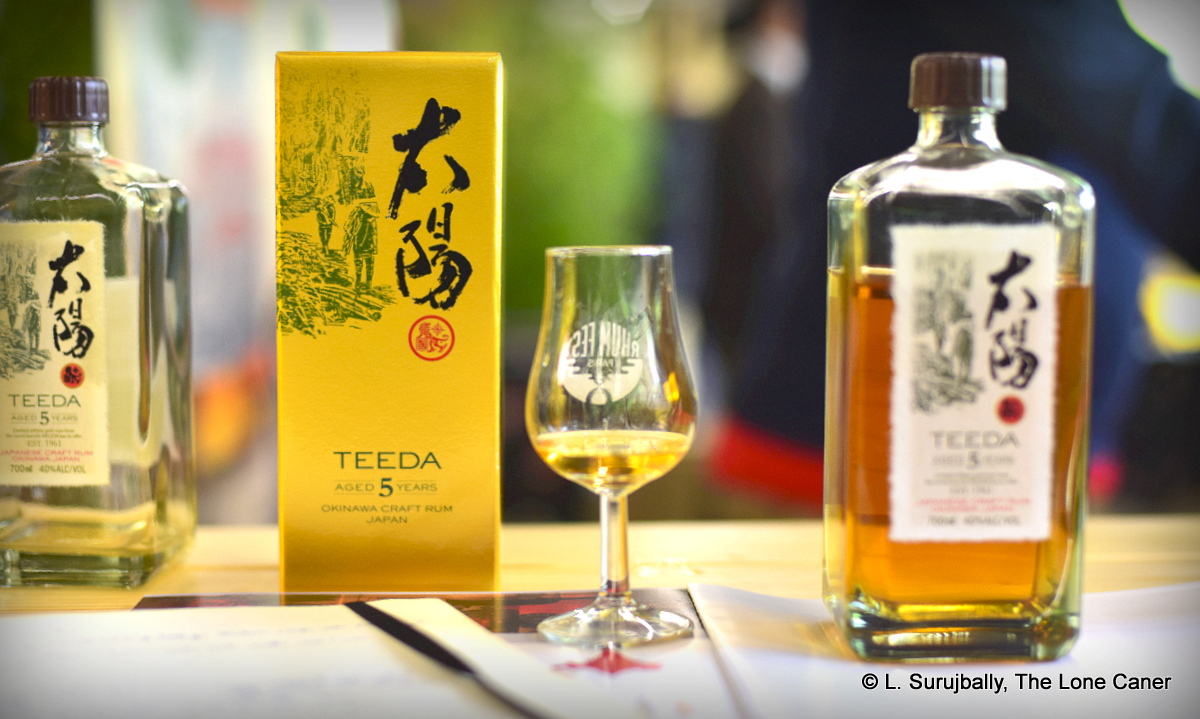
In any rum festival, if you are moving around with a posse or simply keep your ears open, there’s always one or two new or unknown rums that create an underground buzz. You drift from booth to booth, tasting, talking, writing, thinking, listening, and gradually you separate voices from the din, that quietly remark “Check out that one over there” or “Did you hear about….?” or “You really gotta try…” or a simple, disbelieving “Holy crap!”
The Whisper Antigua rum was one of those, Lazy Dodo another; in various years there was the Toucan white, the Compagnie’s Indonesian rum, the first edition of Nine Leaves, the first new Worthy Park rums…and in Paris 2019, it was the Teeda five year old made by the Japanese Helios Distillery, which I heard mentioned up and down the aisles by at least five separate people on the very first day (along with the Madeirans, the Cabo Verde grogues and Mhoba)

Helios has been around since 1961, when it was called the Taiyou distillery, and made rum from sugar cane grown in Okinawa itself (the climate favours it and all rum made in Japan uses cane from there) to cater to the locally-based Americans of the US post-war civil administration – and so as not to use rice which was needed for food to make alcohols like sake. In 1969 as the fortunes of the company and Okinawa improved, the name was changed to Helios and over the next two decades it branched out and gained licenses to make sake, shōchū, awamori (an Okinawan local spirit made from rice), whiskey and, in 1996, beer, which became one of its primary products with amawori and for which it is now best known. Yet they started with and always made a sort of cheap blended rum (both white and lightly aged), and in the last few years expanded that into an aged product they named Teeda (an Okinawan word for “sun” – goes well with Helios, doesn’t it?), which is a blend of rums of five to fifteen years old aged in ex-bourbon barrels, I am led to understand, and pot still distilled. No caramel or other additions, a pure rum.
I don’t know how much of the blend was five years old and how much was greater, but whatever they did, the results were great. The pot still component was particularly aggressive right out of the gate (even with a relatively staid 40% ABV strength) – yes it had a pronounced initial rumstink of sweet fruits and rinds decomposing in the sun, rotting bananas and paint remover, but there was also fanta and soda pop, a clear sweet line of bubble gum and strawberries, apricots, cherries, very ripe yellow mangoes, all tied together with brine, olives, and a really rich vegetable soup chock full of noodles and green onions (seriously!).
Palate…hmmm. Different, yet decidedly intriguing and original without straying too far from rum’s roots. It was supple and firm on the tongue, sweet and almost gentle – I sensed iodine, minerals, wet charcoal, ashes, redolent of that woody and yeasty fresh-baked sourdough action of shōchūs I’ve had, which worked…sort of. Gradually that released additional muskier flavours of licorice, molasses, vanilla, even red olives. It was also musty, with all the pungency of a barn made from old wood and long abandoned. Whatever fruits there were took a back seat, and only really came into their own on the finish which, though short, was creamy and sharp both at once, and allowed final notes of ripe cherries and apricots to make a final bow before disappearing.
What to make of something like this? A Caribbean rum it was clearly not, and it was quite separate from the light rums from South America; neither did it conform to India’s rich and sweet rums like the Rhea or Amrut, and it had little in common with the feral whites now coming out of Asia. Given that in many cases Japanese rum makers are often adding rum to their lineup of whiskies or sake or shōchū as opposed to starting rum distilling from scratch, I argue that too often the profiles of those drinks bleed over into the way their rums taste (Seven Seas, Ryoma, Cor Cor and Ogasawara are examples of this, with Nine Leaves a marked exception).
Yet I liked this thing, quite a bit. It was like a dialled-down Islay mixing it up with a Jamaican pot-still bruiser (with a Versailles acting as referee), and was, in my estimation, something of an original to sample, blending both the traditional “rummy” flavours with something new. It skated over many of the issues mentioned above and came out at the other end with a really mellow, rich, tasty, different rum, the likes of which I have not had before. Even with the few weaknesses it had — the balance and integration of the disparate components were not completely successful, and it could have been stronger for sure — there’s nothing here that would make me tell you to walk away. Quite the reverse, in fact – this rum is absolutely worth a try, and it makes me glad I listened to the buzz.
(#629)(83/100)
Other notes
- Thanks and a hat-tip to Yoshiharu Takeuchi and Manabu Sadamoto for help with the background notes
- A 2019 RhumFest masterclass video of Ms. Matsuda (grandaughter of the founder of Helios) can be found on FB in English, with a running French translation. This confirms the pot still comment (it is stainless steel) as well as noting that fermentation is 2 weeks, leading to a 60% distillate from the still; white rum is rested in steel tanks for about six months, while aged rums are put in oak casks for the appropriate period
No Responses to “Helios Distillery “Teeda” 5 Year Old Japanese Rum – Review”